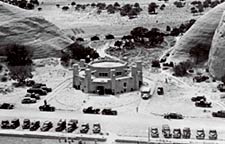
Located in Window Rock, Arizona, the Navajo Nation Council Chamber, is the single-most significant building in the United States symbolizing the New Deal revolution in federal Indian policy, a declaration of economic and cultural self-determination as afforded to American Indians by the Indian Reorganization Act of 1934.
The act sought to replace old policies of detribalization with new policies that advocated the reconstitution of tribal organization, the restoration of a tribal land base and the promotion of traditional Indian culture.
In design and decoration, the Council Chamber was to assert recognition of the unique Navajo cultural contribution to mainstream America, as well as to stimulate pride among Navajos in their own heritage. It was the centerpiece of an ambitious Public Works Administration (PWA) construction program aimed at improving the quality of life on Indian reservations across the country.
Its rustic architectural style was designed to harmonize with its spectacular natural surroundings. Built from 1934 to 1935, the chamber’s octagon shape and structural framework are meant to evoke a giant hogan, the traditional building style of the Navajo. It also incorporates the Navajo ceremonial features of an east-facing main entrance and a windowless north wall.
Today it is the spiritual home of the Navajo political process, embodying the development, growth, and maturity of the Navajo government since it first began using the building in 1936. The Council Chamber is the only legislative headquarters in the United States owned by a American Indian tribe which has been continuously in use by that tribe and whose design incorporates indigenous materials and architectural traditions. The Navajo Nation Council Chamber was designated a National Historic Landmark on June 16, 2004.





